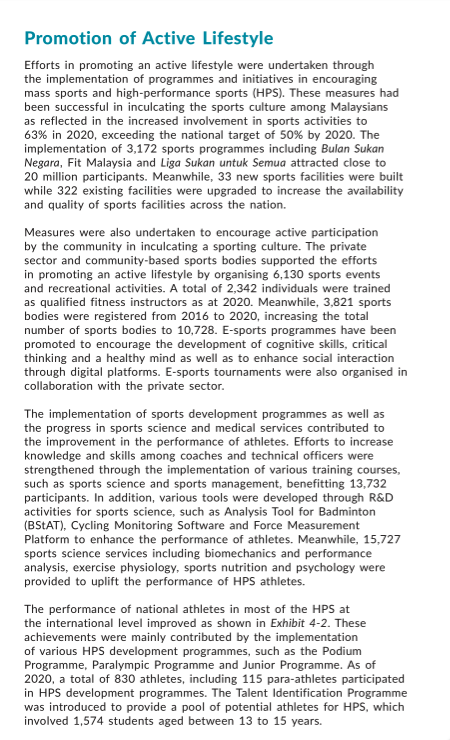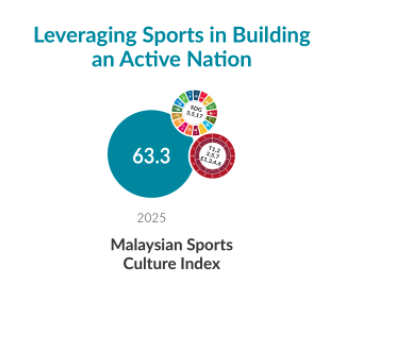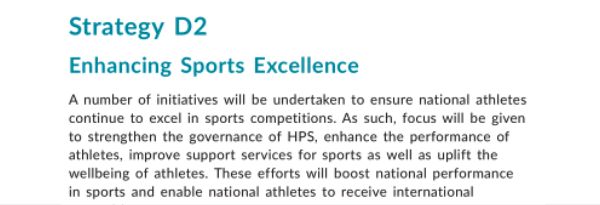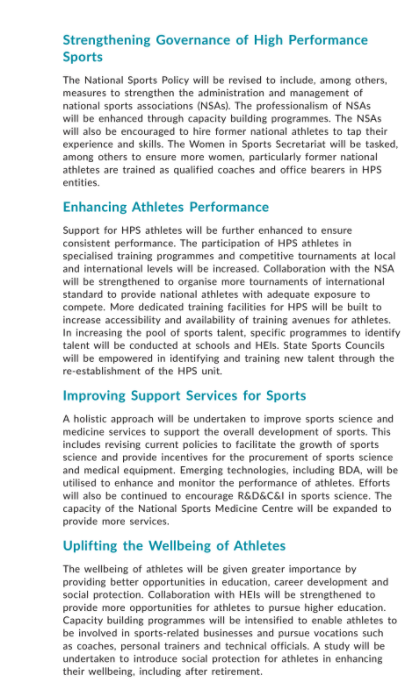RM Ke-12 Sports Policy Analysis: What is the way forward for sports?
Credit: Rojak Daily
So, Malaysia just recently released the Rancangan Malaysia (RM) Ke-12 or the 12th Malaysian Plan, which is supposed to bring about changes for the next 5 years. The whole document essentially worked in this format:
Review of the 11th Malaysian Plan (MP) from 2016-2020 -> Issues and Challenges faced -> Proposal of what to do moving forward in the 12th MP.
Are you involved in the Malaysian sports industry, then you must be interested to know more about the plan they have on sports! Let me bring you through my analysis in my #HighlightsAnalysis Series!
If you’re looking for the general chapter on sports, you must have missed out on it, because it was chosen to be combined together in a chapter with Public Safety, the People’s Wellbeing, and National Unity (which doesn’t make sense to me considering the recent controversies). And it’s just greaaaaaaaaaat to see only ONE sentence in the introduction of the chapter to do with sports:
Not sports being treated as a high impact industry that can not only provide more jobs and opportunities for the people, but also make the nation proud by our athletes succeeding in international competitions. But, instead, sports being used as a ‘tool’ for an active nation and enhancing unity. You could say that the government currently views sports as an industry that will cost them money whereas there is a whole self-sustainable (and possibly profit-making) ecosystem out there. It was not surprising then to see sports as one of the first industries to be closed during the MCO, yet being one of the last industries to be opened when restrictions loosened.
If you like stats, here are some statistics you might find interesting about sports in the 12th MP:
532 pages in the RM Ke-12.
0.5 chapters related to sports.
1 sports-related KPI in the 11th MP.
1 sports-related KPI in the 12th MP.
Review of the 11th Malaysian Plan (MP) from 2016-2020
In the 11th Plan, there was ONLY ONE sports-related target: at least 50% of Malaysians embracing the Sports Culture.
The measures used to determine the success of this metric was:
Participation in mass sports events.
Participation in the community.
High performance sports achievements.
Mass Sports Events
They said that the target has been achieved, with 63% of Malaysians apparently successfully reaching the target. Hooray! But is it as it seems?
Here’s my guess for how they got the 63% figure:
The implementation of the 3172 sports programs throughout the 11th MP attracted close to 20 million participants, so...
20million(participants)/31.95million (Malaysian population) = 62.5% Malaysians "embracing the sports culture".
Here’s my problem with that.
As someone who has experience working with data, I know firsthand how statistics can be easily manipulated to tell a story I want you to hear. Riddle me this, if I attended all 3172 of these organized programs, would I count as 3172/31.95 million people or 1/31.95 million people?
Thus, instead of total number of participants attracted, I want to see number of UNIQUE participants attracted by these events. This figure will show a more accurate representation of whether the 11th Malaysian Plan reached its target or not. Also know that KBS mass events aren’t the only events where people participate in sports. I didn’t attend any of these events but have played my fair share of sports and recreation activities with friends and family on my own.
Participation in the community
Moving onto the second paragraph on this section, it’s said that:
6230 community-based sports events organized.
2342 individuals were trained as qualified fitness instructors.
10728 total sports bodies in Malaysia.
First of all, I can guarantee that there’s been more than 6230 community sports events. We also need the definitions of what is a community-based sports event. Is playing at the taman with my friends considered so? Is booking a badminton court and playing singles considered as such?
Next is the seemingly proud statement that we have a total of 2,342 qualified fitness instructors in the country. According to Statista, a small study involving around 11k people found that 25% of people own gym memberships in Malaysia. So, 25% of the 32 million Malaysian population ends up being around 4 million people supposedly owning gym memberships. Let's say that the sample size of the study is too small and I half that 4 million figure to 2 million gym goers, that’s still a fitness instructor to gym-goer ratio of 1 to 841. That’s even worse than our ratio for doctor to population ratio of 1:454. Is that really something to be proud of?
I give praise to wherever it deserves praise. An increase of more than 55% of the 2016 total of sports bodies is definitely a commendation. However, what qualifies as a sports body? And how many of these sports bodies are considered to be active? How many of these sports bodies are still surviving after the effects of the pandemic? I believe these are all things that KBS Malaysia will have to find out and update the numbers. If a distribution of these organizations can be shared as well in terms of what they do and active status, that would provide a clearer picture of the actual situation in the country.
As I’m not super involved in the esports scene, I can’t comment on the effectiveness of this particular program. I have seen an increase in esports participation though, given the increase in mobile technology and more games being available on such platforms. Tournaments have also been held through e-wallets such as Boost and TouchNGo. But, I still stress the need to pair this with actual physical activities and the need to teach children to not simply trust strangers over the internet.
High Performance Sports
Moving onto the High Performance Sector, I will first deal with the R&D activities to develop tools to help improve athlete’s performance. Paint me the cynical analyst here, but would ISN Malaysia or BAM release the Analysis Tool for Badminton (BStAT) for public use? Doesn’t have to be released for free, you can attach a subscription model to the software to recoup the costs of your R&D. But, if the aim is to improve HPS, why not share it with grassroots badminton players so that grassroot players and coaches can get familiar with the system, then when they get to the higher level, they have already included this system as part and parcel of their game review process? Surely you don’t think only when players get identified as talent, only then you’d provide them the software?
Next, I may be wrong about this one, but from my experience and multiple Google searches, a Force Measurement Platform is essentially a Force Plate? Is Malaysia creating its own metrics to measure the performance of athletes? I remember using the force plate for lab experiments back in 2014 when I was in Loughborough University as part of my Sports Science and Management degree. Again, I may be wrong on this point. I don't work for ISN, so I’m not sure what they may have developed. Please come forward and prove me wrong if I am, ISN Malaysia.
Finally, achievements of HPS in international events have been cited as one of the factors too.
What do you think? Did we improve at a first glance?
For me I don’t see significant differences. Additionally, these figures are essentially telling you a story they want you to hear. The 11th Malaysian Plan was supposed to be executed from 2016 to 2020. So, why are we comparing the result from the 2012 Olympics with the 2016 Olympics? The plan had barely been carried out by then.
If you actually compared the 2016 Olympics results to the 2021 Olympics (the actual span the 11th Malaysian Plan has been in action), we actually took a step back in terms of this.
We sent 32 athletes to the 2016 Olympics, 30 in 2021. In 2016, our medal tally was courtesy of badminton, diving and cycling. In 2021, it came from cycling and badminton.
Badminton went from 3 silvers to 1 bronze. Is there a succession plan for the post-Dato LCW era?
The only improvement came from Cycling Keirin thanks to the Pocket-Rocket man, Azizulhasni Awang. He's 33. How much longer can he compete and perform at such a high level? Who's next? Is it Sahrom?
Diving was also a big sport for Malaysia in the 2012 Olympics, where Pandelela Rinong made the BIG first splash, then followed up with a silver in 2016 with Cheong Jun Hoong. Same question again, who's next? Nur Dhabitah Sabri showed promise, but needs to show consistency. We can’t be expecting her to outperform her world ranking consistently.
Comparing the 2012 Olympics achievements to the 2016 one, sure, we improved by 3 silvers.
Comparing 2012 to the 2021 Olympics? We maintained the status quo. 1 bronze, 1 silver.
Malaysians shouldn't be expecting 30+ year-olds to consistently show up at the international level of sports like Dato' LCW did. Dato LCW is one-of-a-kind, and there might not be another one of him in the next 100 years.
Again, credit where credit is due, in the Paralympics is where we did show some improvements from 2016-2021. Malaysia was able to send one more athlete and earned 2 more silvers in the events we participated. But, our ranking dropped slightly from 36th in 2016 to 39th in 2021.
In terms of the other non-Para international competitions, we didn't show any significant improvement, neither in medal tally, nor rankings. In terms of other Para Games, we DID show improvement, but also not anything significant, except for in the Asean Para Games.
I’ll do you even one better. Malaysian football. For a sport that has been invested in so heavily the past few years, even naturalizing several foreign players, it’s surprising to see so little improvement.
Malaysia’s best FIFA ranking in 2015 was 153rd; in 2016, 156th. Since the implementation of the plan in 2016, 155th in 2017, 167th in 2018, 154th in 2019 and 153rd in 2020.
Significant improvement? You tell me.
Issues and Challenges
At the very least, they do address some of these are my raised concerns in the 'Issues and Challenges' portion of the policy and I respect that.
However, the reasons for lack of participation in mass sports events (like those that KBS organises) was cited as:
Of the rakyat:
poor time management,
sedentary lifestyle
lack of awareness on the importance of active and healthy living
Of the facilities:
limited access to sports facilities
high charges by private sports providers
Of the sports governing bodies:
poor management
lack of professionalism
How convenient that none of it is the fault of the government? Where's the role of the government in all this?
Dealing with the raised issues #1, the government is supposed to be the one who sets policies and offer incentives to encourages a more active lifestyle.
They should be the ones concerned about stressing the importance of a healthy lifestyle and the need to assign time for it no matter how busy someone is.
They are the ones supposed to lead with actions and not just words. How many of our ministers can say they lead an ACTIVE LIFESTYLE? Can our new Sports and Youth Minister boldly claim so?
They are the ones who should organize campaigns, not just mass participation ones, but also cooperating with local communities to organize local sports events, to raise awareness in specific communities and at the same time, help the sporting ecosystem.
Of issue #2, You say prices charged by private sector for facilities are high.
Yes, public facilities maintained by our local councils charge a fairly cheap rental. So, why are people not utilizing the public sports facilities built? Are these facilities being maintained properly? I’ve tried to book public facilities through MPSJ, MPPJ or DBKL, it's like I have to jump through rings of fire, climb through mountains of swords and swim through seas of sharks.
Online? Cannot, system offline. In-person? Gotta wait a whole day to book a 2-hour session for basketball. Book already, show up to play? Sometimes padang no light, sometimes gate is locked, sometimes basketball rims are broken.
In regards to issue #3, Poor management and lack of professionalism stems from the top as well. I don't care to comment more about that.
The situation is best summarized by just ONE sentence in the 3-paragraph-section: "The sports industry as a new source of growth has not been fully capitalized on, mainly due to the ABSENCE OF A CLEAR POLICY."
If you asked me to try to put it in better terms, the sports industry has not even been explored as an economy. And I believe the grassroots community will back me up on this statement. The only thing sports has been used for in Malaysia up till now is... let's say, self-promotion purposes.
OK, so you’ve at least identified the problem. So what to do moving forward?
I’m willing to let bygones be bygones, as they say. Forgive and forget.
The 'Way Forward for 2021-2025'
Priority Area D addresses the need to Leverage Sports in Building an Active Nation.
Strategy D1-Promoting Sports for Active and Healthy Living
Strategy D2-Enhancing Sports Excellence
Strategy D3-Developing Sports Industry
Despite other sectors having multiple clearer KPIs, the sports sector is left with ONE sole KPI – a 63.3 rating in the Malaysian Sports Culture Index (MSCI) by 2025.
Don’t know what the MSCI is? I didn’t too. Have a read of the ‘Introduction’ section of this journal for slightly more information. Essentially, the MSCI I made up of 5 main pillars: Involvement, Passion for sports, Volunteering, Spending and Facility.
Strategy D1 - Promoting Sports for Active and Healthy Living
Strategy D1 comes with 3 substrategies:
Enhancing Accessibility to Sports Facilities
Strengthening Community-Based Sports Bodies
Promoting Inclusive Participation in Sports.
In terms of enhancing accessibility, please DON'T develop a centralised system by yourself with the integrated online booking system. You’ve had years to do that. Instead, look at quick wins by collaborating with existing local applications that already do this. Huddle and Athletes for Athletes (AFA) are existing examples of apps that already do this. Do support them to help push out bookings of existing facilities.
In terms of 'Promoting Inclusive Participation', yes, providing facilities, programs and environment for PWDs, older persons and female community are important. But even more importantly, we have to remove the stigma that certain sports are for certain races only. Just the stereotypes I'm aware of: Football - Malays and Indians, Basketball – Chinese. There are already pioneers in the field showing otherwise, eg. Brendan Gan, Lavere Corbin Ong, and Dominic Tan in football, Dhayalan who played in Taiwan last season and is currently training in Serbia at the moment of writing this article, as well as the whole GoStrong Inc. and Bayang Gelap crew.
Essentially, what I'm trying to say is, opportunities should be given based on their abilities, not connections.
Strategy D2 -Enhance Sports Excellence (essentially elite sports related)
The sub-strategies are as follows:
Strengthen the Governance of High-Performance Sport
Enhance the Performance of Athletes
Improve Support Services for Sports
Uplift the Wellbeing of Athletes
Below is my thoughts:
Hiring former national athletes can only be a good thing, but I want to call for these ex-athletes be equipped with the latest knowledge on sports technology and coaching pedagogy. If their wealth of experience and technical skills can be coupled with the above knowledge, I can definitely see a brighter future for the next generation of athletes.
b/ Properly identify the support services that can improve an athletes performance. Not every athlete requires the exact same treatment/changes.
Don't just follow the trend.
Athletes themselves should be equipped with the knowledge that sports is not just a physical game. Other factors such as, but not limited to: psychological, tactical, nutritional aspects also come into play during a high-level showdown.
Facilities shouldn't be built solely for the usage of the HPS community. By renting out the facility to the public, your talent identification is essentially done for you, on top of commercializing the facility and getting rental fees.
A good example of this that has happened is with the story of Sharul Nazeem and his route to playing for Selangor FC. Previously having played in Liga FAS and KL City League, he was identified as a talent and brought into the FA Selangor ranks.
Not much to say about c) as I've not personally experienced their service. If there’s an advice that I would offer, it would be to focus on improving the services that they already provide, rather than expanding into more avenues.
Regarding point d), if the above steps can be carried out, and a thriving sports economy is created, I don't see ex-athletes being out of jobs after their retirement from pro sports.
Just look at Astro Arena bringing in former shuttlers to provide expert commentary on the Sudirman Cup as an example.
And Finally,all these will crucially depend on …
Strategy D3 - Developing the Sports Industry
And here are the substrategies:
Improving the Sports Industry Ecosystem
Developing the Sports Tourism Segment
For improving the sports industry ecosystem, it's not just about pouring money into the industry, it's about creating a self-sustainable ecosystem where the money is passed through all the different main, complementary and supplementary sports services.
Look to our East and West. US and UK have successfully done so. Japan and Korea are great examples in the Asian Region as well! Even locally, Stadium Astro has done a good job with the STL and that example should be emulated to stimulate interest in the local sports communities.
All in all, the sports industry needs to be commercialized. It can’t stay the way it is.
In terms of promoting sports tourism, I actually do think it's a kind of useless goal due to the fact that we have not enough sports facilities in Malaysia. Tourists are also highly unlikely to come here to watch our professional sports when there's higher levels of competitions in ASEAN alone.
And so, I truly wonder what is it that the government is expecting to change in the near future that can attract tourists to visit Malaysia for the purpose of Sports Tourism? I can see Malaysia being a viable destination in snorkelling, jungle trekking and even golf, but other than that, na-da.
Conclusion and Further Thoughts
With that, that's the last bit of the mention of sports in the RMKe-12. All in all, it's good to have grand ambitions, but does KBS Malaysia have the roadmap to success?
The “Way Forward” has also been very vague and more time will be needed by KBS to draw up strategy-specific policies to achieve what the government wants to achieve by then. Only time will tell if this turns out to be a success or not.
If there’s one thing I’ve taken away as one of the 20 million active grassroots sports participant, I don’t think it’s wise to wholly rely on the Malaysian government to bring about change to the Malaysian sports scene. Instead, I will endeavor to be the change I wish to bring about and I hope everyone who is reading through this will be able to play a part as well, no matter how small.
Before signing off, I would like to apologize if I have offended or wronged anyone or any organizations through my line of opinions. It is not my intention to do so, instead I'm simply offering my humble view as an active participant of grassroots sports, providing a bottoms-up perspective to what the government perceives are the problems & solutions from a top-down perspective.
Feel free to start rational debates and discuss your difference in opinions with me. I’m mainly active on twitter as @mengM3ngz.
Thank you for spending the time to read through this article and I hope you all have a nice day ahead, my fellow ahli #KeluargaMalaysia.










